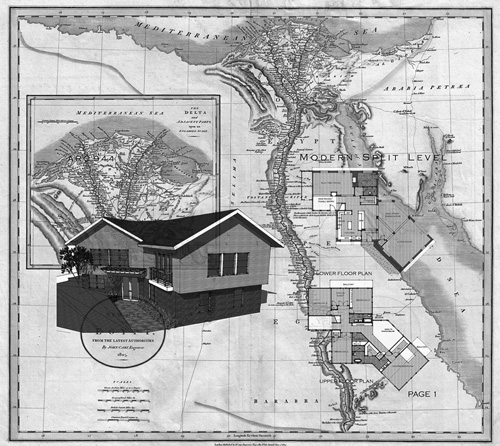Arts & Culture
Worlds apart, under one roof
Exhibit links artist’s life experiences, Egypt’s upheaval
 By JOHN SEVEN
By JOHN SEVEN
Contributing writer
NORTH ADAMS, Mass.
Julia Morgan-Leamon’s “Split/Level” takes a suburban housing style from the 1970s and reshuffles it into a metaphorical zone that’s part personal history and part global reality.
The exhibition, which opened July 31 and remains on view through Aug. 24 in Gallery 51 at the Massachusetts College of Liberal Arts, is a multimedia work that makes significant use of video and sculpture. The resulting split-level house both parses and links the artist’s personal past in the United States with the political present in Egypt.
Although she lives and works in the Berkshires, Morgan-Leamon became a regular visitor to Egypt in the years leading up to its 2011 revolution, and her experiences there and connections to the Egyptian arts scene have become integral to her work.
“There are so many intense stories that have been swirling around me, and there comes a point when you’re almost going to explode if you don’t try to feel the connection between these things and express it,” Morgan-Leamon said. “It feels almost like I don’t know whether I should write these stories or create art about them. They’re narratives that are part of my life that are so strange and poignant that I feel like I need to do something with them, make some kind of sense with them.”
Morgan-Leamon said she focused on video, rather than painting, as the medium central to this show to increase the vibrancy and immediacy of the narratives – and to make incidents from the past become current and dynamic. Video, she noted, has the capacity to manipulate time.
“I don’t know how to use painting in a way that suggests a story like this, or an atmosphere,” Morgan-Leamon said. “I feel limited in painting. Video has the potential to change space more than paintings, and I am trying to somewhat alter things a little bit in an architectural way.”
Show curator Holly Edwards describes the exhibit as its own split level, a gallery “divided into two zones -- the front one conjuring the domestic arena of Julia’s childhood, the back zone evoking her experiences in Egypt.”
The latter specifically focuses on an emotional encounter with an Egyptian woman, whose reaction to news that her mother had died in an accident in the desert awakened Morgan-Leamon’s traumatic memories about her own mother.
Morgan-Leamon said she didn’t want to comment on her own grief so much as to connect hers with the woman’s -- to reveal the common experience of grief regardless of life experience or setting.
“I want people to feel different rifts in experience and how it’s a human situation to deal with loss and to deal with stretching oneself and to deal with rifts in our lives and connecting the dots and making meaning out of things,” she said. “I’m trying to do it without putting my own story there explicitly, trying to suggest that aspect of living a human life and these things that we all deal with. … It’s happening through the body. The body is the center of perception, so what is the body feeling?”
Egyptian connection
Morgan-Leamon’s first visit to Egypt is something she remembers as being akin to a fever dream, hot and intense and filled with extremes that took place 20 years ago and never quite seemed real to her.
Finally able to return with her family after a decade, her stay in an archaeologist’s hotel on the Left Bank in Luxor introduced her to several Egyptian artists who changed her life. One of them became a well-known artist during the revolution of 2011 and became a faculty member at the Luxor College of Art, an element that would become a constant in Morgan-Leamon’s life.
“I just got the sense of it being this potentially amazing art center there,” she said. “On my way out, the last day, I ended up meeting someone who was higher up in the Ministry of Culture, and he said, ‘Oh, we’re starting this art center there. We’re doing this art symposium for teachers.’”
Morgan-Leamon applied and wound up serving as an international artist there for a month, then returning regularly in the same role for several years. In the United States, Morgan-Leamon had been teaching at Williams College and began to consider how to connect the two experiences for an artistic cultural exchange between the sets of students she had at each end.
“I just thought how amazing would it be to have these two groups of young artists connect with each other,” Morgan-Leamon said. “You travel other places like that and you mostly only see the superficial skin of the culture, and this was the real thing. These were people really motivated by the art, really all invested in being there, and the revolution hadn’t happened yet, but there was this general sense of real dedication to what they were doing.”
Painting through a revolution
Students became part of Morgan-Leamon’s travel mix for several years leading up to the revolution. Just before it started, the U.S. students left Egypt, but Morgan-Leamon was left behind to witness it all firsthand.
“I stayed and was pretty much in the midst of it, painting watercolors and walking around these people and just being generally amazed by the way these people were taking their voice to the streets,” she said.
Morgan-Leamon kept returning to Egypt again after the revolution, although she wasn’t able to go last year. Instead, she brought her Egyptian faculty associate Alaa Awad to North Adams, where his work was featured in a separate MCLA exhibit earlier this summer. And in June, Awad completed a huge, 60-foot-long mural along the base of the Route 2 overpass downtown.
Morgan-Leamon said she hopes to return to Egypt this fall on her own.
“It feels really important that through this door of the arts that there is this possibility for free dialogue,” she said. “Just having brought Alaa here, and the way he has talked to the people on the streets, really changed something in the town -- something shifted because of his presence here, and that happened to the students when they were over there.”
She added that she wants to continue to extend her own experience and connections with Egypt to others. Her eventual goal is to start some kind of small arts and cultural institute that would link American students to the region as a way of bridging the gaps in understanding between these two parts of the world – and of offering opportunities for growth and collaboration at an early level of art education.
It’s an endeavor that Morgan-Leamon likens to her own painting practices. What happens before the art, she believes, is as important as the actual creation of it.
“I don’t really try to represent Egypt, though I am really interested in the layers of history and the layers of language, the layers of time, all these things that feel like there’s a lot of depth to them,” Morgan-Leamon said. “Sometimes I’ve just been creating these layers of watercolor construction things that felt somehow like I was getting at something, but I’m not sure what it will be. Right now it’s more of a communication through the arts and our dialogue to the arts.”

